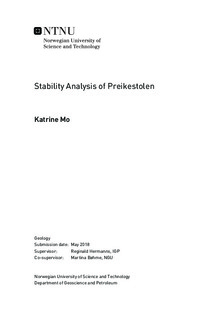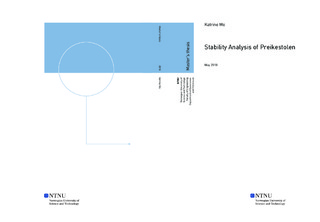| dc.description.abstract | The Geological Survey of Norway (NGU) in currently in the process of mapping all unstable slopes in Rogaland county. This master thesis is included as a supplementary part of this and focuses on the stability assessment of Preikestolen. The stability was investigated through structural mapping in the field supported by 3D analyses, using LiDAR and photogrammetry (drone and single lens reflex camera). In addition, a 2D numerical analysis was carried out in the RS$^2$ program, with calculations of the factor of safety.
Detailed geological mapping of Preikestolen revealed that the rock formation consist of two lithologies. The upper and lower part consist of porphyritic granite devided by a section of granitic gneiss. Structurally the study area can be divided in three domain with Preikestolen being the central one. The area is characterized by two steep joint sets J1 (213/87) and J2 (126/86), in addition to the shallower dipping joint set J3 (141/52). All the structures were mapped in the field and on the high resolution 3D models. The orientation of joints is indistinguishable, as they are almost identical in all models. However there is a variance in the foliation measurements. Field data indicate a dip towards the NW, while the 3D data suggest a dip towards SW.
Three remote sensing techniques were used to create 3D models of Preikestolen, including ground based LiDAR scanning, photogrammetry with drone and photogrammetry from helicopter (with a Nikon D 800 camera). A relatively high focus on remote sensing techniques is present throughout this thesis, as was requested by NGU. The main focus of the 3D models in this study, was the use for structural mapping. Based on the compared data sets, the photogrammetry models were evaluated as sufficient replacements for the ground based LiDAR scanner, dependent on several factors. Therefore throughout planning prior to fieldwork, and knowledge on how the different factors like vegetation, light conditions, accessibility in field, among others, are evaluated as important to successfully decide which remote sensing technique that will be most suitable for the specific site.
The input parameters for the numerical model were gathered both in the field and though laboratory testing of rock-samples from Preikestolen. The stress used in the model is based on existing in-situ stress measurements from the area along Lysefjorden, as there were no existing measurements at Preikestolen. The geometry of the model is based on a high quality point cloud produced with photogrammetry that was rasterized and combined with an existing 10 m digital elevation model.
The numerical simulation includes three versions of the slope (Model 1, 2 and 2a). Model 1 is an elastic model with the Hoek-Brown failure criterion. In model 1, only the profile of the rock formation was included. Model 2 was simulated as plastic material, with the joint extensions observed in the field included. In model 2a (plastic material), the joint was extended in order to daylight the slope. For model 2 and 2a, the Mohr-Coulomb failure criterion was applied. The simulation of model 2 resulted in a high critical strength reduction factor as the joints present at the plateau does not fully go through the rock mass at the toe of the slope. However, even when this joint was extended, the safety factor was still high. In the numerical model, the failure occurs through the joint located at the back end of the plateau, which is defined as scenario A.
Furthermore, observations from the field and 3D models are included in a risk-matrix. One matrix was made for each of the scenarios, where scenario B has the highest hazard score. The join crossing the plateau, which is the back fracture in scenario B, is fully developed. For scenario A, the fracture is only partly developed across the slope which contributed to the lower hazard score. The hazard score for both models have a large uncertainties, as no data on acceleration, displacement rates or bathymetric data (past events) exists. Updating of the hazard score once measurements from the extensometers at Preikestolen are available, is therefore recommended. | |

